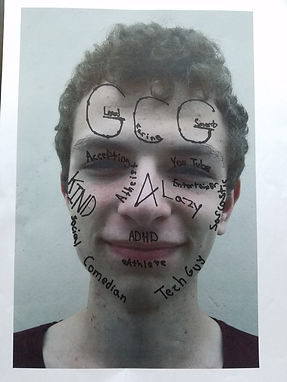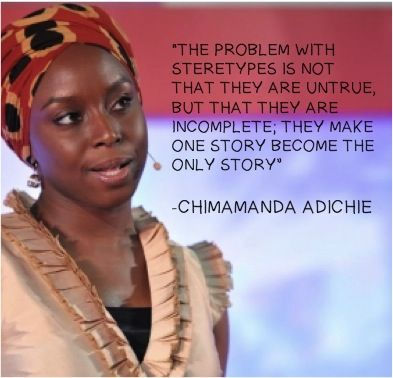
STEREOTYPES AND LENSES
This class had a heavy focus on Critical Lenses and perspective.
The first thing we did with perspective was take pictures of our faces. On those pictures we wrote things that we though other people thought about us and things we associated with ourselves.


Next we looked at the dangers of a single story. This led us to look at the works of James Baldwin, read an excerpt from Gloria Anzaldua's "Borderlands", watch a TED talk by Chimamanda Adiche about the danger of a single story, and write our own equity mantras. We took what we learned and read and had several Socratic seminars where we discussed the deeper meanings and overarching messages that these works conveyed.
For our equity mantras we were tasked with writing a one sentence statement that we could as a rule to live by to treat everyone equitably. My mantra was "Know someone before passing judgment on them"
Literary Theories
During the latter half of the semester we focused heavily on Literary Theories
-
Queer Theory: Gender studies and queer theory explore issues of sexuality, power, and marginalized populations in literature and culture.
-
Psychoanalytic Theory: Psychoanalytic criticism builds on Freudian theories of psychology.
-
Post-Colonial Theory: Post-colonial criticism assumes a unique perspective on literature and politics that warrants a separate discussion. Specifically, post-colonial critics are concerned with literature produced by colonial powers and works produced by those who were/are colonized.
-
Feminist Theory: Feminist criticism is concerned with "...the ways in which literature reinforce or undermine the economic, political, social, and psychological oppression of women".
-
Critical Race Theory: Critical Race Theory, or CRT, is a theoretical and interpretive mode that examines the appearance of race and racism across dominant cultural modes of expression.
DOCUMENTARY
As we moved along with our unit about the dangers of a single story we went to go see the documentary "I Am Not Your Negro" which we used as inspiration on how to use interviews to tell a story. We then formed groups and were tasked with interviewing several people and using their responses to tell their stories in the form of a documentary.
After we had interviewed our candidates we then combed through the videos and pulled out key quotes that we could use in conjunction with other quotes from the other interviews to draw common themes between two subjects.
The next stage of the project was to take the quotes we had set aside and write a script based around those quotes where as the script went on the viewer gets to know more and more about each subject and we are the narrator serving the purpose of drawing similarities between both subjects.
Once all that was complete we were able to compile all the clips together and when combined with our narration and expert creative direction we created our documentary in its entirety.